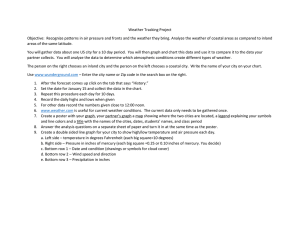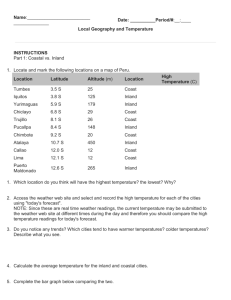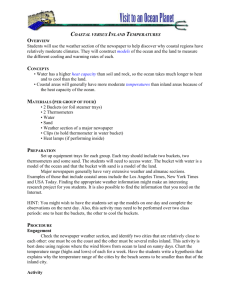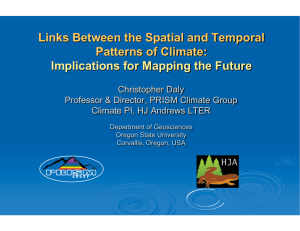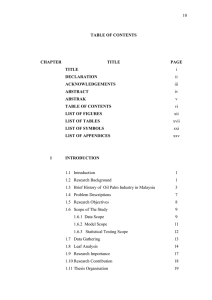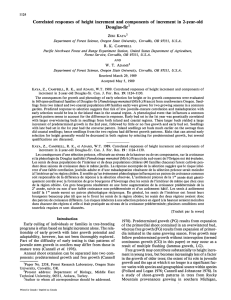E.ES.07.73 Fall 10
advertisement
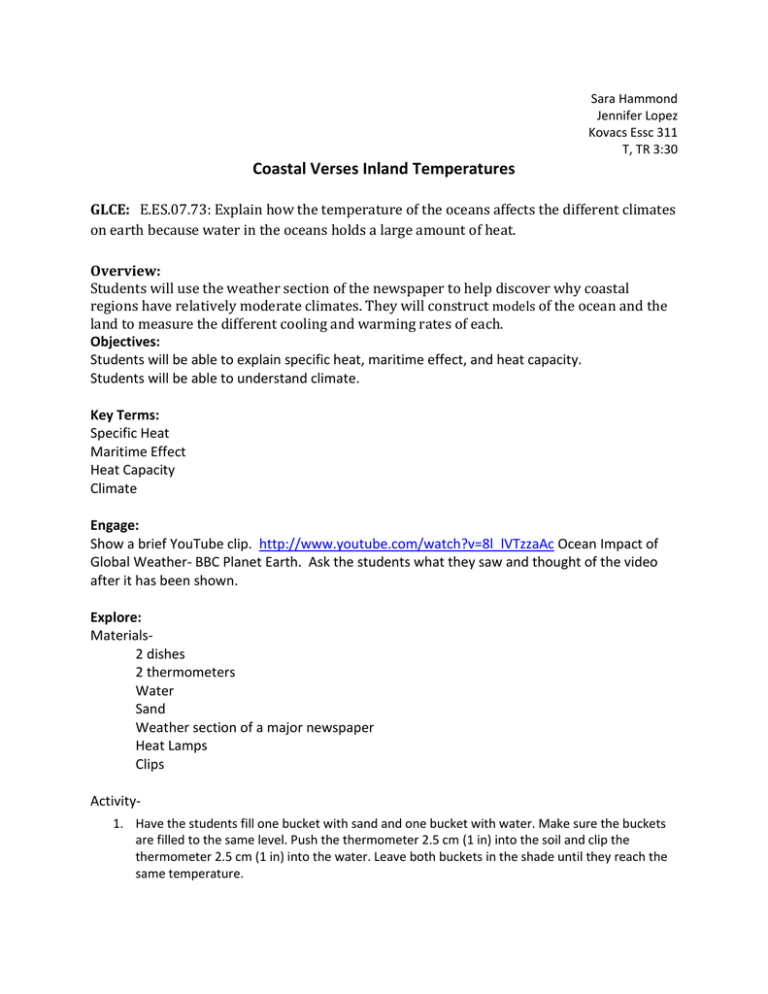
Sara Hammond Jennifer Lopez Kovacs Essc 311 T, TR 3:30 Coastal Verses Inland Temperatures GLCE: E.ES.07.73: Explain how the temperature of the oceans affects the different climates on earth because water in the oceans holds a large amount of heat. Overview: Students will use the weather section of the newspaper to help discover why coastal regions have relatively moderate climates. They will construct models of the ocean and the land to measure the different cooling and warming rates of each. Objectives: Students will be able to explain specific heat, maritime effect, and heat capacity. Students will be able to understand climate. Key Terms: Specific Heat Maritime Effect Heat Capacity Climate Engage: Show a brief YouTube clip. http://www.youtube.com/watch?v=8l_lVTzzaAc Ocean Impact of Global Weather- BBC Planet Earth. Ask the students what they saw and thought of the video after it has been shown. Explore: Materials2 dishes 2 thermometers Water Sand Weather section of a major newspaper Heat Lamps Clips Activity1. Have the students fill one bucket with sand and one bucket with water. Make sure the buckets are filled to the same level. Push the thermometer 2.5 cm (1 in) into the soil and clip the thermometer 2.5 cm (1 in) into the water. Leave both buckets in the shade until they reach the same temperature. 2. Once the temperature in both buckets is the same, put them in direct sunlight. Check and record the temperature every minute until a clear trend in the data is seen. Plot and graph the temperatures versus time. 3. Move the buckets back into the shade (into a refrigerator is better, if available). Measure and record the temperature every minute until a clear trend is seen. Plot and graph the data. 4. Have the students fill out the worksheet below while doing the activity. Heat Capacity of the Earth's Surfaces Name_____________________________ 1. Record your data in the table below: Time (min.) Soil Temperature (ºC) Water Temperature (ºC) Start 1 2 3 4 5 6 7 8 9 10 2. Draw two line graphs comparing the change in Soil Temperature and the change in Water Temperature over Time in the graph below. Don't forget to label each of the lines to distinguish between the two graphs. 3. Do you notice any patterns? Which had the greatest increase in temperature? The least? 4. Calculate the total change in temperature for the soil and water: _______ ºC • Students will be measuring the heat capacity of water versus sand. • In a regular classroom this activity may require two class periods, one for measuring heating and the other for measuring cooling. Explain: • Prior Knowledge: • Convection Currents- the circular motion in a liquid, solid, or gas caused by heating and cooling. • Energy in relation to temperature- thermal energy held by an object, which is the kinetic energy of motion of the particles of matter. • Model- a representation of an object that is downsized or enlarged. • • • • Sun energy source for Earth Unequal distribution of heating Land heats & cools faster than water Explain Vocabulary words • Specific Heat • Heat Capacity • Maritime Effect • • Explain that because of waters ability to hold its temperature at a more constant rate, this prevents it from being subject to extreme temperature changes. Therefore, land masses that are close to large bodies of water will experience more moderate temperatures. Explain that the moisture and temperature that is present for a large body of water is carried and distributed to the land that is near it via wind currents. Thus, a tropical ocean will produce a tropical climate to the land masses that are near it. Elaborate: • • • Have students select two cities from anywhere in the world. One city must be a coastal city and the other one should be an inland city from the same latitude. The students will record the temperature and weather conditions of their 2 cities for a week through the newspaper or internet. The students will then graph their data and answer the following two questions: • What factors influence different weather in each place? • Is proximity to a large body of water the only influence of the weather in your cities? NAME: Coastal vs. Inland Climate Your homework assignment for this week is to “adopt” two cities. Please use a globe or atlas to select two cities from around the world. One city must be a coastal city and the other city must be inland. Both cities must be at approximately the same latitude. You will be charting each city’s temperature and precipitation for the next seven days. Please use the following websites to assist you: http://worldweather.wmo.int/index.htm http://www.worldatlas.com/aatlas/world.htm 1. City 1: City 2: Cities Chosen: 2. Record your data below: City 1 Minimum Temp City 2 Minimum Temp City 1 Maximum Temp City 2 Maximum Temp City 1 Precipitation City 2 Precipitation Day 1 Day 2 Day 3 Day 4 Day 5 Day 6 Day 7 3. Please create a line graph of your two cities’ minimum and maximum temperature on a separate paper. Evaluate: Give the students a short quiz on this topic. Include key terms and why one material heats and cools faster than the other material.
